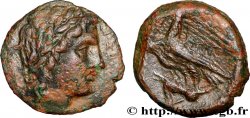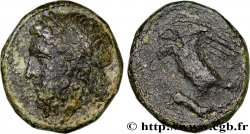bgr_993782 - SICILY - AKRAGAS Hemilitron
Not available.
Item sold on our e-shop (2025)
Price : 180.00 €
Item sold on our e-shop (2025)
Price : 180.00 €
Type : Hemilitron
Date: c. 282 - 279/278 AC.
Mint name / Town : Agrigente, Sicile
Metal : copper
Diameter : 19,5 mm
Orientation dies : 12 h.
Weight : 5,55 g.
Rarity : R2
Coments on the condition:
Monnaie centrée à l’usure importante mais régulière. Revers agréable. Patine marron
Catalogue references :
Obverse
Obverse legend : ANÉPIGRAPHE.
Obverse description : Buste d’Artémis à gauche, les cheveux coiffés en arrière et ramenés en petit chignon ; carquois sur l’épaule ; grènetis circulaire.
Reverse
Reverse description : Sanglier à gauche.
Reverse legend : BASILEOS// FINTIA, (Basileos Fintia)
Reverse translation : (Roi Phintias).








 Report a mistake
Report a mistake Print the page
Print the page Share my selection
Share my selection Ask a question
Ask a question Consign / sell
Consign / sell
 Full data
Full data









